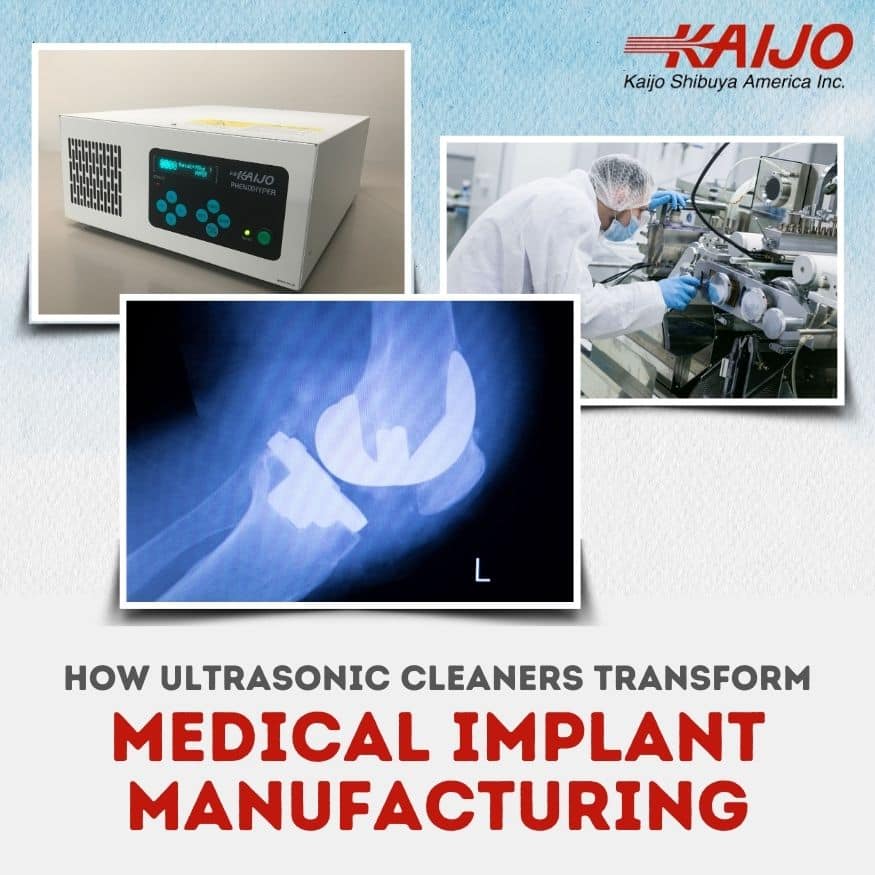Ultrasonic Cleaners Transform Medical Implant Manufacturing
December 5, 2024
 Summary: As medical implant designs become more sophisticated, manufacturers are turning to advanced ultrasonic cleaning systems to ensure consistent quality, regulatory compliance, and efficient production processes.
Summary: As medical implant designs become more sophisticated, manufacturers are turning to advanced ultrasonic cleaning systems to ensure consistent quality, regulatory compliance, and efficient production processes.
Product cleanliness directly impacts patient safety and device performance in medical implant manufacturing. Traditional cleaning methods often fall short of today’s rigorous standards, especially given the intricate designs and complex materials used in modern implants. Medical ultrasonic cleaners address these challenges by using high-frequency sound waves to achieve thorough cleaning at the microscopic level. This advanced technology ensures consistent quality while meeting strict regulatory requirements, making it an essential tool in modern medical device production. As manufacturers face growing demands for precision and efficiency, ultrasonic cleaning systems provide a reliable solution that transforms how medical implants are prepared for patient use.
The Unique Challenges in Medical Implant Manufacturing
Complex Design Geometries
Modern medical implants feature intricate surface patterns, microporous structures, and complex geometries that enhance biological integration. These design elements create significant cleaning challenges that ultrasonic cleaners effectively address:
- Deep recesses and undercuts: Ultrasonic cleaning easily reaches deep recesses and undercuts, ensuring contaminants are thoroughly removed.
- Microscopic pores: Cavitation generated by ultrasonic cleaners penetrates microscopic pores, providing thorough cleansing.
- Varying surface textures: Ultrasonic cleaning ensures uniform cleaning across different surface textures, adapting to each implant’s requirements.
- Delicate features: Ultrasonic cleaning is gentle enough to protect delicate implant features while still providing a high level of cleanliness.
Material Diversity and Cleaning Requirements
Medical implants use various biomaterials, each needing specialized cleaning. Ultrasonic cleaners offer tailored solutions and the precision required to clean these unique materials, ensuring safety and quality.
| Material | Challenges | Ultrasonic Cleaning Solutions |
| Titanium Alloys | Preservation of surface oxidation layers | Gentle cavitation protects the oxidation layers |
| Sensitivity to chemical cleaning agents | Use of inert, non-corrosive cleaning solutions | |
| Need for precise temperature control | Digital temperature regulation ensures stability | |
| Stainless Steel | Prone to corrosion if not properly cleaned | Ensures thorough removal of machining oils and residues |
| Specific pH levels required | Customizable cleaning solutions to maintain proper pH | |
| Cobalt-Chromium Alloys | Sensitive to surface scratching | Specialized cleaning protocols to prevent scratches |
| Validation of cleaning effectiveness | Validation features provide documented evidence | |
| PEEK (Polyetheretherketone) | Temperature-sensitive | Gentle cleaning methods regulate temperature |
| Maintenance of surface properties for biocompatibility | Ultrasonic cleaning maintains essential surface properties |
Ultrasonic cleaning technology effectively addresses the challenges of cleaning these materials, providing a thorough, validated cleaning process that ensures all implants meet the highest standards of cleanliness and integrity.
Why Ultrasonic Cleaners Are Used in Medical Device Manufacturing
Technology Overview
Medical ultrasonic cleaners harness the power of cavitation – a sophisticated physical process where high-frequency sound waves generate and collapse microscopic bubbles in cleaning solutions. This creates intense localized cleaning forces that penetrate deep into component surfaces. The process generates consistent cleaning patterns across components while protecting delicate surface features. Frequency control and power modulation ensure optimal cleaning for different materials and geometries, making it significantly more effective than traditional cleaning methods.
Role in Medical Device Manufacturing
Ultrasonic cleaning technology provides critical advantages in medical device production:
Production Efficiency
- Reduces manual handling requirements
- Shortens cleaning cycle times
- Enables batch processing capabilities
Precision Cleaning
- Removes contaminants from complex geometries
- Achieves uniform cleaning across entire surfaces
- Maintains material integrity during the cleaning process
Regulatory Compliance
- Provides documented, validated cleaning processes
- Ensures consistent cleaning parameters
- Supports FDA and ISO requirements
The technology’s ability to combine thorough cleaning with process control makes modern medical device manufacturing essential.
Key Benefits of Using Medical Ultrasonic Cleaners
Enhanced Cleaning Efficiency
Medical ultrasonic cleaners minimize production downtime while improving product quality, thanks to advanced frequency controls and consistent cleaning parameters. These features lead to faster production without sacrificing quality.
Improved Quality Assurance and Consistency
Ultrasonic cleaning systems deliver reproducible results through advanced parameter control:
- Frequency modulation that adapts to different materials
- Digital power control systems maintaining optimal cavitation
- Real-time monitoring of solution conditions
- Automated cycle timing with precision controls
- Temperature regulation within 1-degree tolerance
These controls ensure consistent cleaning across production batches while significantly reducing quality variations.
Regulatory Compliance and Process Control
Medical device manufacturers face stringent FDA and ISO requirements for cleanliness validation. This includes compliance with ISO 13485:2016 for quality management systems, ISO 14971:2019 for risk management, ISO 10993 for biocompatibility evaluation, and IEC 62304 for medical device software processes. Ultrasonic cleaning systems support compliance through the following:
Process Control Features:
- Digital parameter logging and storage
- Real-time monitoring of cleaning effectiveness
- Automated alarms for out-of-spec conditions
- Calibration tracking and maintenance records
Validation Capabilities:
- Installation Qualification (IQ) documentation
- Operational Qualification (OQ) protocols
- Performance Qualification (PQ) support
- Process validation data collection
Quality Documentation:
- Automated cycle reporting
- Parameter trending analysis
- Statistical process control integration
- Complete audit trail generation
- Risk management documentation aligned with ISO 14971:2019
- Biocompatibility validation records supporting ISO 10993
- Software validation documentation meeting IEC 62304 requirements
The controlled nature of medical ultrasonic cleaning extends beyond basic operation. Advanced systems incorporate multiple feedback loops monitoring cavitation intensity, power delivery, and solution conditions. These systems automatically adjust parameters to maintain optimal cleaning conditions, compensating for variables like:
- Changes in solution temperature
- Varying load sizes and material types
- Solution degradation over time
- Environmental condition fluctuations
This level of control ensures consistent, validated cleaning processes that meet the most demanding regulatory requirements while providing comprehensive documentation for quality systems.
Choosing the Right Ultrasonic Cleaner Manufacturer
Medical device manufacturers gain significant advantages from partnering with experienced ultrasonic cleaner manufacturers:
- Reduced Validation Time: Proven protocols speed up validation, leading to faster production readiness.
- Lower Implementation Risks: Validated processes reduce integration risks for smoother implementation.
- Faster Production Startup: Optimized parameters lead to quicker production.
- Enhanced Compliance: Documented processes ensure adherence to regulatory standards.
- Cost Efficiency: Custom solutions reduce overall costs, streamlining production.
Key Specifications and Features
When evaluating ultrasonic cleaner manufacturers, these critical capabilities ensure successful implementation:
Technical Specifications
- Multi-Frequency Options: Enables cleaning of various material types, enhancing versatility.
- Precision Power Density Control: Protects delicate components while ensuring effective cleaning.
- Customizable Tank Configurations: Supports varying production volumes for better adaptability.
- Digital Process Control Interfaces: Ensures consistent operation, improving reliability.
- Advanced Temperature Management: Protects materials by maintaining optimal temperature.
Material Compatibility
- Expertise with Various Materials: Proven expertise with titanium alloys, stainless steel, and PEEK ensures effective cleaning.
- Protocols for Different Surface Finishes: Established protocols guarantee compatibility with various finishes.
- Validated Processes for Porous Surfaces: Ensures effective cleaning of porous and textured materials.
- Surface Integrity Preservation: Techniques to maintain the integrity of delicate surfaces during cleaning.
- Cross-Contamination Prevention: Methods to prevent contamination between different materials.
Regulatory Understanding
- FDA Compliance Experience: Documented experience with FDA compliance ensures smooth regulatory approval.
- ISO 13485:2016 Quality Management System Certification Support: Expertise in supporting ISO quality management certification requirements.
- ISO 14971:2019 Risk Management compliance expertise: Support for ISO risk management compliance requirements.
- ISO 10993 biocompatibility testing support documentation: Support for ISO biocompatibility testing.
- IEC 62304 compliance for automated control systems: Support for IEC compliance for automated control systems.
- Comprehensive Validation Documentation: Detailed documentation to facilitate regulatory processes.
- Risk Assessment Capabilities: Ability to conduct thorough risk assessments to ensure cleaning safety.
- Process Validation Protocols: Proven protocols to validate cleaning processes, supporting regulatory needs.
Partnering with Kaijo ensures manufacturers have guidance on integration and compliance, giving them a competitive edge.
Kaijo’s Expertise in Medical Device Cleaning
Kaijo offers specialized ultrasonic cleaning solutions for medical implant manufacturing that address the complex challenges of modern implant designs. Their systems are specifically engineered to handle:
- Intricate implant geometries and surface textures
- Diverse biomaterial cleaning requirements
- Critical cleanliness standards for patient safety
- Strict regulatory compliance documentation
The Phenix Hyper system, operating at 78kHz, delivers precise cleaning power optimized for medical implants. This specialized frequency provides:
- Thorough removal of manufacturing residues
- Protection of critical surface properties
- Preservation of biocompatible coatings
- Consistent cleaning across varying implant designs
Kaijo’s Water Resonance System (WRS) technology creates uniform cavitation fields that reach every surface for enhanced cleaning of intricate implant designs. This innovation particularly benefits:
- Implants with microporous surfaces
- Components with textured finishes
- Devices with complex internal features
- Parts requiring validated cleaning processes
The system’s dynamic power modulation maintains consistent cavitation intensity throughout the cleaning cycle, preventing damage to delicate surfaces while achieving thorough cleanliness. Real-time process monitoring provides immediate feedback on cleaning effectiveness, while integrated validation systems automatically document critical parameters for regulatory compliance.
Kaijo partners with implant manufacturers to:
- Develop validated cleaning protocols
- Optimize process parameters
- Ensure FDA compliance
- Maintain production efficiency
- Support documentation requirements
This comprehensive approach ensures medical implant manufacturers achieve consistent, validated cleaning results while maximizing production efficiency and maintaining regulatory compliance.
Conclusion
Integrating medical ultrasonic cleaners in implant manufacturing has revolutionized how manufacturers achieve consistent, validated cleanliness. As medical devices grow more complex and regulatory requirements become more stringent, this technology provides reliable solutions for critical cleaning challenges.
Looking ahead, ultrasonic cleaning technology will become increasingly vital as implant designs evolve. Advanced features like Kaijo’s Phenix Hyper technology and Water Resonance System demonstrate the continued advancement in meeting these emerging challenges while maintaining strict quality standards.
Contact Kaijo for a Free Consultation
Our experts will work with you to determine the proper frequency, power level, and cleaner design for your specific application. Contact us today for a free consultation to learn how our high-precision medical ultrasonic cleaning solutions can significantly reduce your cleaning times and improve your manufacturing process.





